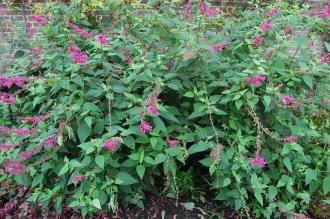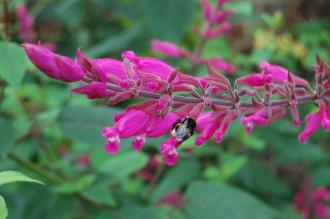
Salvia involucrata ‘Boutin’ (08/11/2015, Kew Gardens, London)
Position: Full sun to light shade
Flowering period: Late summer to autumn
Soil: Moist, well drained
Eventual Height: 1.2m
Eventual Spread: 90cm
Hardiness: 8a, 8b, 9a, 9b, 10a, 10b, 11
Family: Lamiaceae
Salvia involucrata ‘Boutin’ is an deciduous herbaceous perennial with a bushy habit. Its mid green leaves are ovate with entire margins, up to 12cm long and 5cm broad. Its leaves are fragrant when crushed. Its pink/ purple flowers are up to 1cm long and appear as a terminal spike which are up to 20cm long.

Salvia involucrata ‘Boutin’ Flower (08/11/2015, Kew Gardens, London)
The species Salvia involucrata, commonly known as Rose Leaf Sage, is native to Mexico. In its native habitat it grows at the edge of forests.
The etymological root of the binomial name Salvia is derived from the Latin salvare, meaning to ‘save’ or ‘heal’, in reference to its historical use as a medicinal plant. Involucrata is derived from the Latin involutus meaning ‘wrapped in’.
The landscape architect may find Salvia involucrata ‘Boutin’ useful as a late flowering shrub with attractive foliage suitable for herbaceous border type planting schemes. Once established this plant is drought tollerant.

Salvia involucrata ‘Boutin’ Leaf (08/11/2015, Kew gardens, London)
Ecologically, Salvia involucrata ‘Boutin’ flowers are attractive to pollinating insects and hummingbirds.
The Royal Horticultural Society have given Salvia involucrata ‘Boutin’ their prestigious Award of Garden Merit in 1996.
Salvia involucrata ‘Boutin’ prefers moist, humus rich, well-drained soils. It tolerates most pH of soil.
Salvia involucrata ‘Boutin’ requires little maintenance. Necessary pruning should be carried out in early spring before growth begins.

Landscape Architecture

